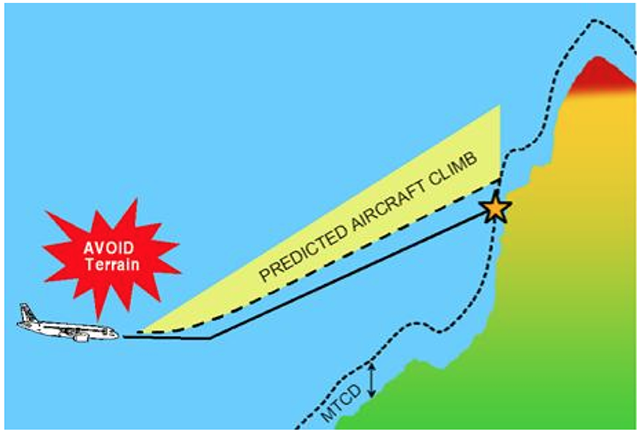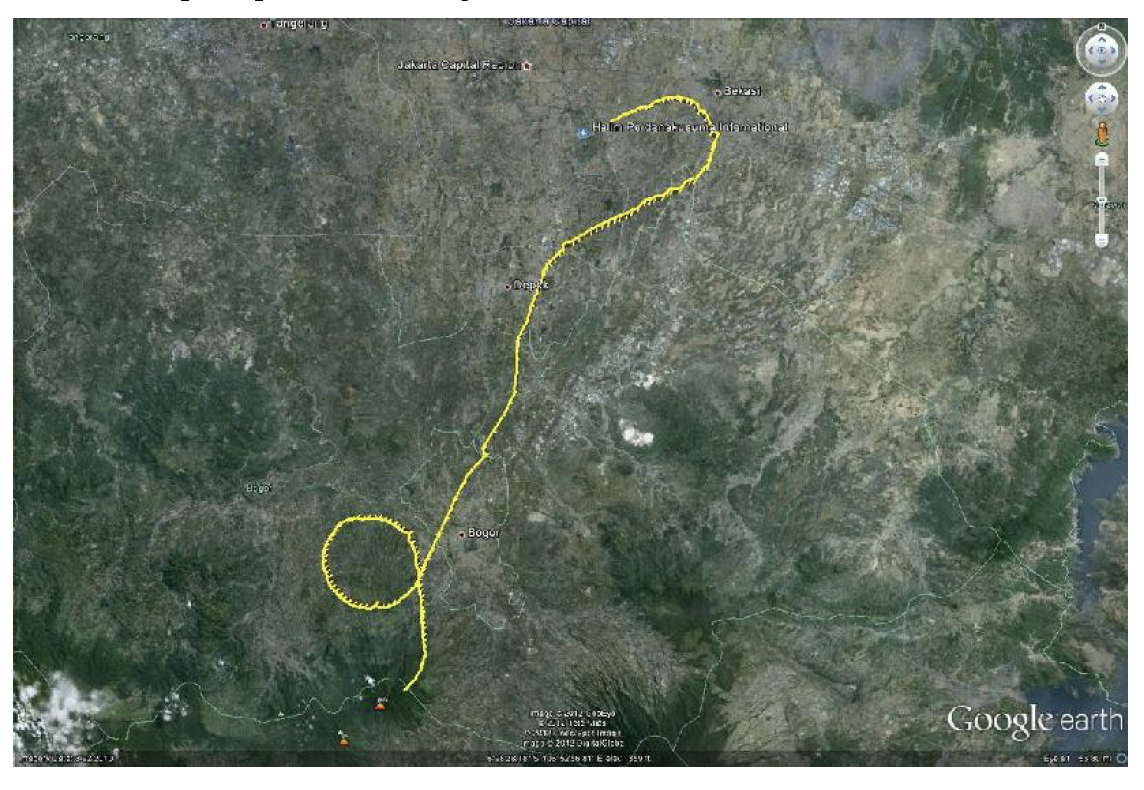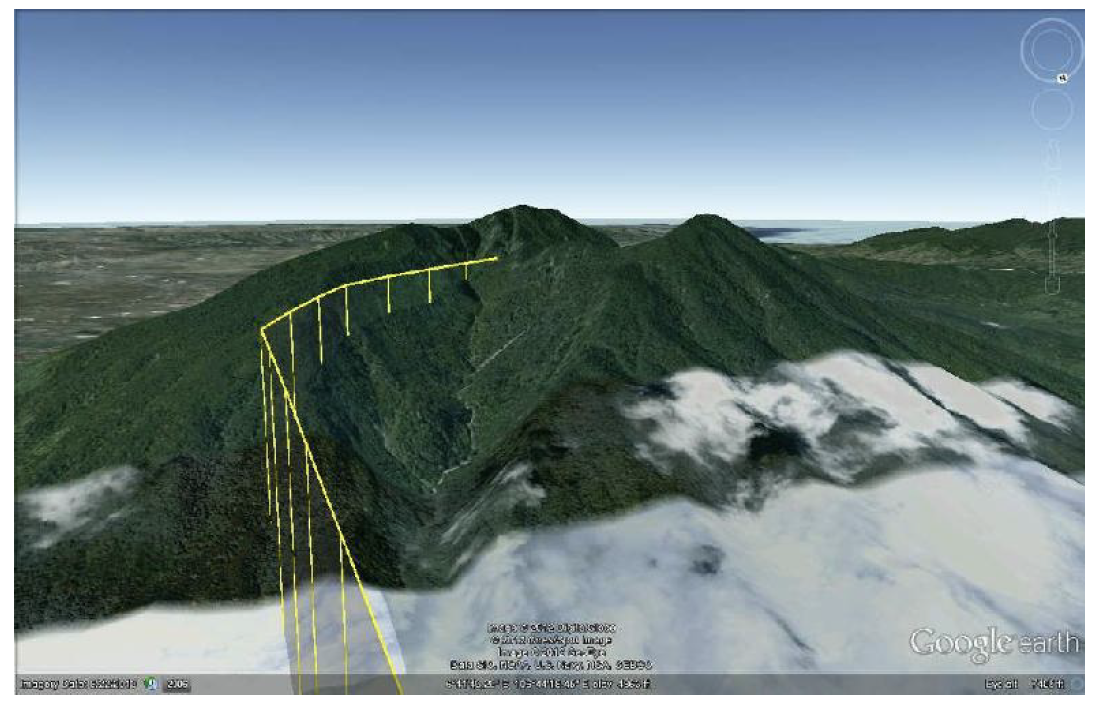As is usually the case with these Controlled Flight Into Terrain mishaps, there was a lot going on during this flight. Ironically, the crew was explaining the Terrain Awareness and Warning System (TAWS) system to cockpit guests just two minutes before the first "Terrain Ahead Pull Up" warning. The captain's reaction was to dismiss it as a database problem. Had he reacted correctly, they would have lived. Instead, thirty seconds later, all aboard perished.
— James Albright

Updated:
2014-03-24

TAWS Avoid Terrain Warning, from
Indonesia Investigation Report, Figure 2.
So ignoring escape maneuver procedures was certainly a factor. The crew also had poor situational awareness. During their TAWS explanation to their guests, the crew both noted "no problem with terrain" and "it's flat." It certainly was not.
Finally, the crew did not have terrain charts which clearly depicted the magnitude of the terrain in the local area.
Many modern aircraft provide excellent visual depictions of the local terrain and a good Enhanced Ground Proximity Warning System (EGPWS) goes a long way to providing situational awareness. But it is all for naught if the pilot's don't have a situational understanding of the terrain and fail to abide by EGPWS/TAWS warnings.

1
Accident report
- Date: 9 May 2012
- Time: 14:32
- Type: Sukhoi Superjet 100-95B
- Operator: Sukhoi Civil Aircraft
- Registration: 97004
- Fatalities: 4 of 4 crew, 41 of 41 passengers
- Aircraft Fate: Destroyed
- Phase: En route
- Airport: (Departure) Jakarta-Halim Perdana Kusuma Airport (HLP/WIHH), Indonesia,
- Airport: (Arrival) Jakarta-Halim Perdana Kusuma Airport (HLP/WIHH), Indonesia
2
Narrative

Ground plot,
Accident Report, Fig. 7
- A Sukhoi RRJ-95B aircraft, registered 97004 and with flight number RA 36801 on 9 May 2012 was on a demonstration flight. The accident flight was the second of two scheduled demonstration flights.
- At 0726 UTC, the pilot contacted Jakarta Approach and requested for descent to 6,000 feet. The Jakarta Approach controller asked the SIC to repeat the request.
- The SIC repeated the request for descent to 6,000 feet. Subsequently, Jakarta Approach controller responded and acknowledged the request by replying “6,000 copied”. The pilot replied: “Descending to 6,000 feet”.
- At 0728 UTC, the SIC requested to make a right orbit, the Jakarta Approach controller approved the flight to make right orbit at 6,000 feet.
- The Jakarta Approach controller on duty stated that the radar display indicated that the aircraft was over WI(R)-4 Atang Sanjaya Training Area when requesting the orbit. The WI(R)-4 airspace area extends from ground to 6,000 feet. The area was at about 17 Nm southwest of HLM VOR.
- At 0750 UTC, according to the Daily Report provided by Air Traffic Services Operation, the controller on duty noticed that the flight target disappeared from the radar monitor.
- At 0752 UTC, the controller on duty attempted to contact the RA 36801 flight three times. At 0754 UTC, the Jakarta Approach reattempted to contact the RA 36801 flight and there was no reply.
- On 10 May 2012 at 0135 UTC, the location of the aircraft was identified by the Search and Rescue helicopter pilot. The probable location was determined using Jakarta Approach radar plot calculation and the SAR team used that information to locate the accident aircraft.
- The aircraft wreckage was found on a ridge of Mount Salak on 28 Nm HLM VOR on radial 198, at approximately 6,000 feet. According to the Flight Data Recorder (FDR) data, the impact point was recorded at coordinate 06°42’45”S 106°44’05”E.
Source: Accident Report, § 1
T2CAS
- The aircraft RRJ-95B was equipped with Terrain and Traffic Collision Avoidance System (T2CAS) which incorporates independent Traffic Collision Avoidance System function (TCAS) and Terrain Awareness Warning System function (TAWS).
- However, the TCAS system will not be discussed in this report as this had no link to this accident.
- The purpose of the TAWS is to provide terrain situational awareness aiming to prevent Controlled Flight Into Terrain (CFIT) situations. TAWS as a situational awareness system is not to be used as a primary navigation means of the aircraft.
- TAWS warnings take into account the current configuration and climb capabilities of aircraft (including gross weight, center of gravity, flaps and gear position, engine status, etc.), flight parameters (including vertical speed, flight path angle, ground speed, track angle, latitude and longitude, air temperature, roll, Global Positioning System (GPS), barometric altitude, and radio altitude), and terrain database.
- Pilot reactions to alerts and warnings will differ according to local regulation authorities, weather conditions, type of warning, phase of flight, and aircraft performance.
- Pilots should be trained to react to TAWS alerts and warnings according to their company’s policy. Training programs will be required for TAWS just as they are required for basic GPWS, aircraft stall warning, windshear, engine failures and other emergencies.
- Pilots should react to all TAWS aural alerts, display pop--ups and visual annunciations as required by company policy. The amber CAUTION requires immediate attention if the condition continues. The red WARNING annunciation is a TAWS warning and requires immediate action by the pilot.
Source: Accident Report, § 1.6.3
The report says the TAWS system "had no link to this accident" but I'm not so sure. The report says had the pilots heeded the TAWS warnings they would have lived. But why didn't they heed the warnings?
Cockpit Voice Recorder (CVR) Extracts

Flight path,
Accident Report, Fig. 16
- The PIC demonstrated the aircraft ability for making holding pattern on the FMC
- (SIC) Mentioned that sometimes the ground can be seen through the clouds.
- (PIC) Six thousand, ALT STAR.
- The PIC demonstrated TAWS feature of “terrain” by displaying the terrain on the EFIS.
- Furthermore the PIC stated “but no problem with terrain, at this moment”.
- Aircraft Heading 070°
- (Guest) ”Ya, it’s flat…”
Source: Accident Report, § 1.11.2
It is hard to fathom anyone saysing "it's flat" to this part of the world and you might argue that it was the guest and not one of the pilots saying it. But the pilots appeared unfamilair with the area and perhaps the statement had an influence on their thinking.
The heading at the moment was away from highest terrain but also away from the airport.
- Guest and pilots discussion related to a guest question of aircraft fuel consumption.(PIC) commanded SIC to request for right turn for approach.
- Roll angle decreasing
- (SIC) Asked the PIC intention whether to make another orbit or return to Halim.
- (SIC) Repeated the previous question.
- (PIC) “What?”
- Aircraft reached heading 174°
- (SIC) repeated the previous question.
- (PIC) “We will make approach”
- (SIC) mentioned that he will make the request after the turn is completed.
- (PIC) commanded SIC to request now. The PIC then humming tried to determine the heading for return to Halim.
Source: Accident Report, § 1.11.2
Their initial flight was to the south so the correct heading would be to the north. The PIC was using the heading mode of the autopilot which now had them flying south. With each repeated question they continued to fly south.
- (SIC) I can check in this LEGs (FMC Pages)
- (PIC) “Look at LEGs (page) which one?”
- The SIC could not find heading reference for return to Halim on the LEG page. The SIC then calculated the heading by referring to the out bound heading.
- The PIC questioning the SIC’s calculation.
- The SIC still could not determine the heading for return to Halim.
- The PIC stated the heading to Halim was 020
- (SIC) OK
- (PIC) On heading 020 for VOR DME approach
- (PIC) Commanded the SIC to request to Jakarta Approach heading 020 and descent to 1,600 feet for VOR DME approach
- Aircraft heading 174°
- Heading selector set to 325°
- Aircraft initiated right turn with a bank angle of 20°. Then the bank angle smoothly decreases.
- (PIC) “Just request quickly”
- (SIC) Ok.
Source: Accident Report, § 1.11.2
The PIC appeared to realize they were headed the wrong way but didn't understand the gravity of the situation. The new heading selector heading was in the right direction, but for some reason the aircraft stopped its turn.
- TAWS Aural warning: “Terrain Ahead Pull Up”
- TAWS Aural warning: “Avoid Terrain”
- TAWS Aural warning: “Avoid Terrain”
- (SIC) “What is that?”
- TAWS Aural warning: “Avoid Terrain”
- TAWS Aural warning: “Avoid Terrain”
- TAWS Aural warning: “Avoid Terrain”
- TAWS Aural warning: “Avoid Terrain”
- Chime sound
- TAWS inhibited
- (PIC) “may be ... data base”
- FWS Aural warning: “Gear not down”
- Pulse Side Stick (SS) movement to pitch at 5 with duration of 2 seconds resulting in autopilot disengage.
- The SS movement and FWS aural warning "GEAR NOT DOWN" occurred simultaneously.
- Chime sound twice Pressing SYS and TERR buttons
Source: Accident Report, § 1.11.2
The PIC appeared to disable the TAWS warnings.
- Trickle sound 11 times
- Autopilot OFF
- (SIC) “What is that?”
- (PIC) Autopilot OFF
- End of recording
Source: Accident Report, § 1.11.2
3
Analysis
Pilot Experience
- License : Test Pilot I (First class)
- Type rating : Let L-29, -39, -410; Mikoyan MiG-15, -17, -21, -23, -25, -29, -31; Sukhoi Su-7, -9, -17, -22, -24, -25, -80, RRJ-95B;Antonov AN-26, -30, -72, -124-100; Ilyushin Il-76; Boeing 737-200; Tupolev Tu-134, -154B/М, -204, -214; Yakovlev Yak-40; Airbus А-320, -319.
- Total time : 10,347 hours
Source: Accident Report, § 1.5.1
The report doesn't go into the depth of the pilot's experience in all these aircraft but on first examination you would think he was well practiced with automated cockpits. His type rating include a Boeing and two Airbus aircraft after all.
Allow me to speculate. I once flew with a Gulfstream GV pilot who was a graduate of the USAF test pilot program and had on his resume over 100 aircraft types flown and about twenty type ratings. I was dumbfounded by the fact he was one of the worst pilots I had ever flown with until I figured it out. When he went to test pilot school, they gave him nearly 100 aircraft types to fly and record data. He was responsible only for getting the aircraft off the ground, flying a few maneuvers, and then landing the thing safely. Of course that is an achievement, but it hardly teaches you much about real world flying. All those type ratings were what I call "gift" ratings. Our company put a lot of pilots through FlightSafety and we had gratis initial type rating schools. This guy represented our company and FlightSafety wasn't about to fail him. He had an impressive resume, but he didn't know the first thing about flying.
If you are wondering how any professional pilot could become situationally unaware in the situatation this crew found itself in, I hypothesize that the pilots were impressive in their own ways, but not when it came to flying passenger carrying aircraft in instrument conditions.
- For the purposes to evaluate the aircraft system and pilot actions on the accident flight, a simulator test was performed using the simulator Flight Training Devices (FTD) at the SCAC facility in Russia. The simulation was performed by the SCAC and the Gromov Flight Research Institute (Russia) test pilots. The simulation was performed by using FDR recording data. The route of the accident flight was up-loaded in the simulator FMS. The simulator TAWS was up-loaded with a digital map of Indonesia terrain database, the same that was installed in the accident aircraft.
- Conclusion of the simulator test: The collision with the terrain could be avoided if the crew performed the appropriate actions in responding the TAWS warning within 24 seconds after the first TAWS warning activated.
Source: Accident Report, § 1.16
- The pilot intention to descend to 6,000 feet and subsequently make an orbit was to lose altitude. The intended landing runway was runway 06. The aircraft position at that time was too high to make an approach. This situation differed to the first demonstration flight that landed on runway 24.
- The PIC asked the SIC to request a right turn for return and approach. The SIC did not respond.
- The SIC asked the PIC’s intention to continue the orbit or return to Halim. This question was not responded to by the PIC and the SIC repeated the question 3 times. The PIC replied that he intended to return.
- The FDR data revealed that the roll angle was decreasing.
- Aircraft reached a heading of 174 degrees.
- The SIC then mentioned that he would make the request to Jakarta Approach controller after the orbit was completed. The PIC commanded the SIC to make the request immediately.
- The orbit was performed by selecting the ‘heading selector’ on the Main Control Panel (MCP) initially to 333° and subsequently to 033°, 103°, 150° and 174°.
- The reducing roll angle indicated that the aircraft heading was close to the intended heading. The aircraft then stopped the turn and flew on a heading of 174° as selected on the ‘heading selector’. At this point, the aircraft had exited the orbit. The orbit was initiated while the aircraft was on heading of 200° and stopped on a heading of 174° instead of returning to a heading of 200°. The complete 360° orbit had not been completed.
Source: Accident Report, § 2.1
The report doesn't go into detail about the autopilot and FMS capabilities to fly this "orbit," but it appears the pilot was using a "brute force" method to simply rotate the heading bug repeatedly to new headings. This works but the method is very risky because you have to keep spinning the heading selector.
- The PIC set the heading to 174° at 07:30:14 and subsequently his attention was distracted with conversation not related to the progress of the flight. The pilots may not have noticed that the aircraft had exited the orbit and assumed that it was still continuing to turn. This was evident as at 07:31:58, the SIC mentioned that he would make the request to Jakarta Approach controller after the orbit was completed, however the aircraft had stopped turning at 07:31:53.
- At this time, the aircraft was flying on a heading of 174° for approximately 4 Nm. The PIC’s intention to descend indicated that he was not aware of the mountainous area surrounding the flight path.
- The FDR data revealed that the SYS and TERR button of the TAWS were switched off. This indicated that the PIC inhibited the TAWS system. The chime indicated the deactivation of the TAWS. The PIC inhibited the TAWS assuming that the warning might be triggered by a problem with the TAWS terrain database.
Source: Accident Report, § 2.1
4
Cause
The report does not list causes but instead gives conclusions, the most important are extracted here.
- The flight crew was not aware of the mountainous area in the vicinity of the flight path due to various factors such as available charts, insufficient briefing and statements of the potential customer that resulted in inappropriate response to the TAWS warning.
- Distraction of the flight crew from prolonged conversation not related to the progress of the flight, resulted in the pilot flying not constantly changing the aircraft heading while in orbit. Consequently, the aircraft unintentionally exited the orbit.
- There was 1 TAWS aural warning of “Terrain – Pull up” and 6 “Avoid Terrain” aural and visual warnings.
- The PIC inhibited the TAWS system function, assuming that there was problem with the TAWS database.
- The simulation test concluded that the TAWS was functioning properly and the impact could be avoided by appropriate reaction of the pilot up to 24 seconds after the first TAWS warning.
Source: Accident Report, § 3.1
In the words of the report, the flight crew was not aware of the mountainous area, suffered from distraction, and failed to react appropriately to the TAWS warning. All of that is true, but none of that is what caused this accident. What caused the accident was the selection of pilots who didn't understand cockpit automation and were not trained to a standard to fly in the aircraft they found themselves flying that day.
References
(Source material)
(Indonesia) National Transportation Safety Committee Aircraft Accident Report, Sukhoi Civil Aircraft Company, Sukhoi RRJ-95B, 9 May 2012